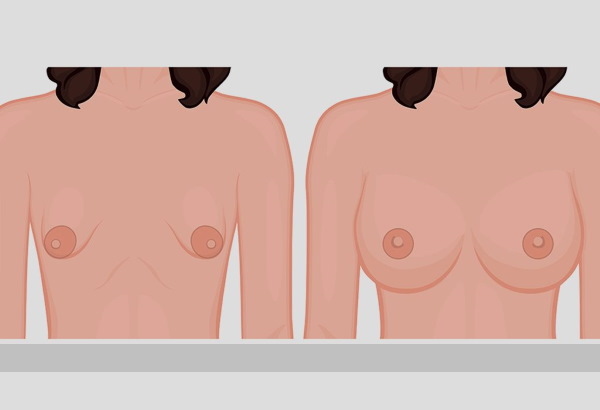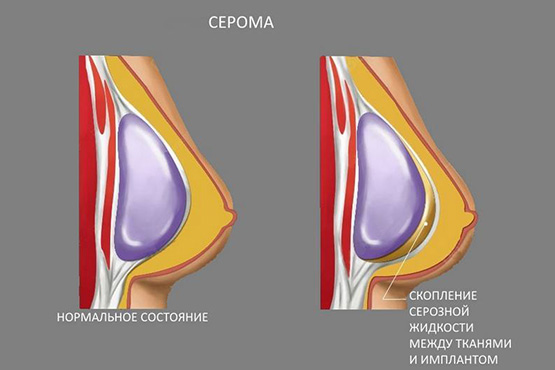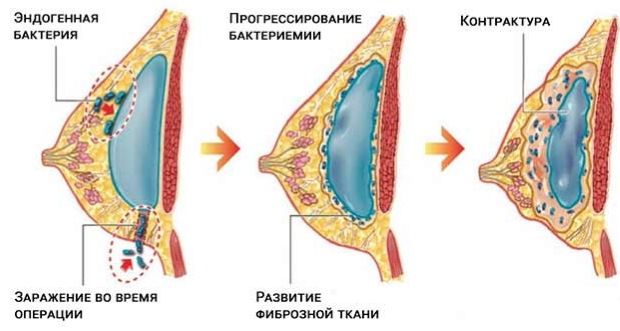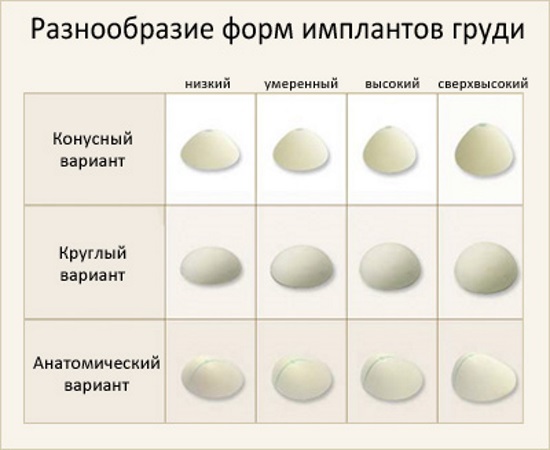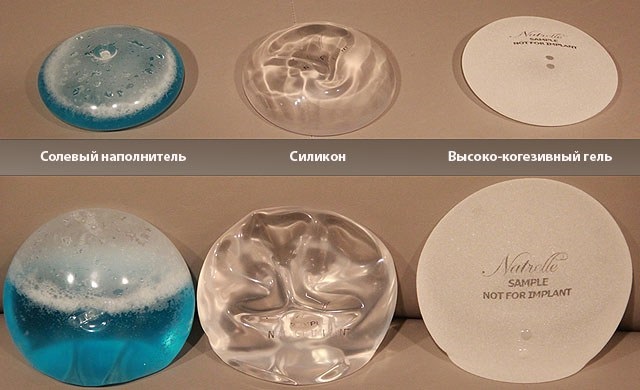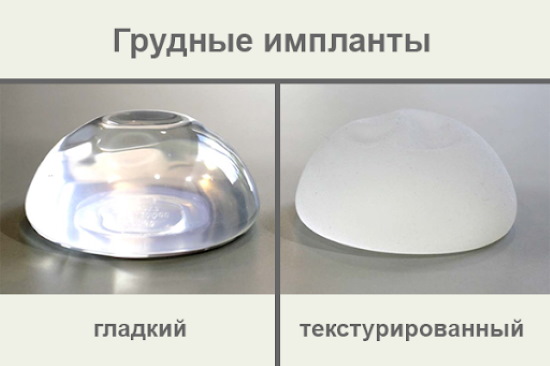Tubular breasts (mammary glands) are common during adolescence. The anomaly may be congenital. Pathology has a number of characteristic features, there are several main forms of its development, depending on the severity.
What is tubular breast shape, signs
The tubular form of the mammary glands is a developmental anomaly, against the background of which the area of the base of the breast decreases, mastoptosis, hernia of the alveoreal type and a deficiency of connective tissue develop. The glands acquire a characteristic tubular elongated shape.
There is unilateral and bilateral lesions, the areoles bulge slightly. Pathology is diagnosed in 20-25 patients out of 1000. Patients rarely seek medical help due to the fact that the disease is practically asymptomatic. Pathology is considered an aesthetic defect.
An anomaly is revealed during external examination. Depending on the extent of the lesion, the chest has a cylindrical or conical shape. At the base, the organ narrows, the interthoracic space is enlarged.
Development of glandular ptosis is possible. The mammologist often discovers the underdevelopment of the areoles, they are enlarged and do not correspond to the patient's age. The nipples are dense, structural abnormalities are observed (for example, retraction).
In rare cases, an alveolar hernia is diagnosed, which is manifested by the protrusion of the nipple complex. Subjective symptoms such as discomfort or pain are absent.

A woman may have difficulty breastfeeding her babycaused by a decrease in the volume of the mammary gland. A child cannot latch on to the breast correctly with an abnormal structure of the areola-nipple complex.
Causes of the appearance of a tubular breast
The tubular form of the mammary glands develops for a number of reasons.
Scientists have put forward several theories of the occurrence of pathology:
- Acquired factors. A number of researchers do not consider the pathology to be congenital due to the absence of changes in the areolar-nipple complex until adolescence. The reason for the development of the tubular form, in their opinion, is a violation of blood flow inside the mammary glands.
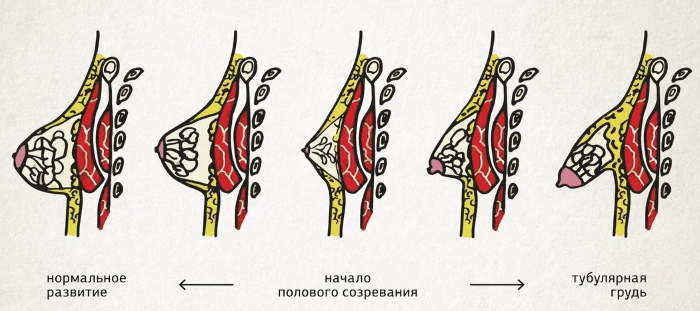
- Teratogenic factors. The anomaly occurs against the background of biological or chemical effects on the fetus developing in the womb.
- Hereditary factors. Tubular breasts can be transmitted through the female line from mother to daughter. The key genes that are responsible for the development of the disease have not yet been identified.
With "goat's breast", dense bridges are formed inside the mammary glands (one or two), preventing the normal growth of glandular and adipose tissues.
Tubular breast after childbirth
The tubular form of the mammary glands cannot develop during gestation or when breastfeeding.
An aesthetic defect cannot be considered acquired. Pathology is not an absolute contraindication to lactation. Women with a grade 2 or 1 anomaly can breastfeed their baby.
The aesthetic deficiency does not in any way affect the quantity and quality of milk. Women with grade 3 may have trouble capturing the areola and nipple in the baby. The mother should choose the right position during feeding so that air does not enter the baby's stomach. Deformation of the mammary gland does not affect lactation in any way.
Tubular breast in a teenager
The tubular form of the mammary gland in adolescents appears at the time of puberty. The number of glands in the chest increases 8-12 times. Tubular lobes are intensively formed.

The mammologist can confirm or deny the diagnosis after the mammary gland is fully formed. The development of pathology is in no way connected with the maintenance of strict diets: the disease is inherent in a person from the moment of his birth
Types and degrees of tubulation
The tubular form of the mammary glands is not considered a life-threatening condition. The disease does not require urgent mammoplasty. The gland usually vaguely resembles a mushroom in shape. There are several main degrees of tubulation.
Among them, the type of disease is separately distinguished, which are characterized by:
- conical and tubular shapes;
- prevalence of vertical size over horizontal;
- small base of the mammary gland;
- lack of breast volume.
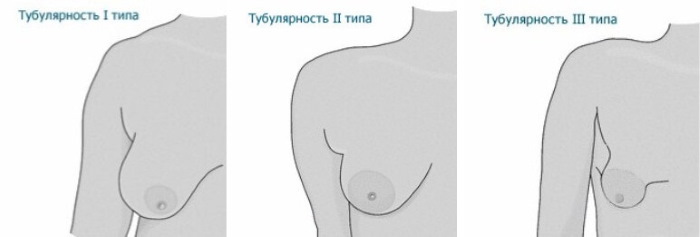
The lower part of the breast is narrowed, the areolae and nipples are lowered. There is a pronounced asymmetry.
Initial degree
Grade 1 breast tubulation is considered the mildest form that does not require correction. The aesthetic defect is poorly expressed: the breast is slightly raised, the areola-nipple complex is not changed.
The growth of the mammary gland is difficult against the background of the formation of bridges formed from connective tissue. They are located in the lower and medial quadrants.
Second degree
In the second degree, tissue deficiency forms in the lower quadrant. The mammary gland is slightly lowered or shifted downward. During a visual examination, nipple hardening and enlargement of the areolar lobe can be detected.
Third degree
Grade 3 tubulation is considered the most severe. In a woman, a sheath of connective tissue forms inside the mammary gland, narrowing the glandular base and preventing its growth. There is a tissue deficiency. There is a high risk of developing an alveolar hernia.
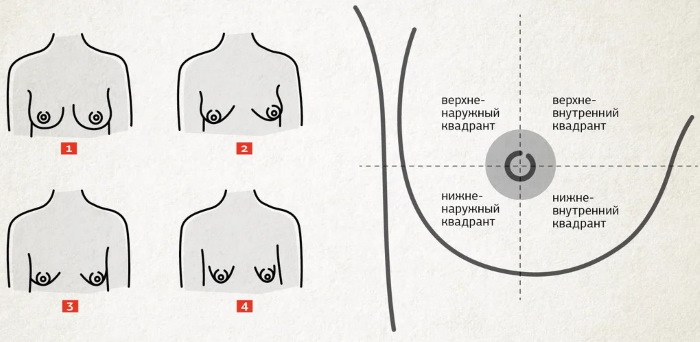
Due to the sharp expansion of the areola-nipple complex, the breast grows towards the nipple. In the third degree, experts recommend choosing an implant to eliminate the defect.
Features of tubular breastfeeding
Women with 2 and 3 degrees of tubulation do not have problems during breastfeeding. The pathology does not affect the quality and quantity of milk.
The woman does not experience pain or other discomfort while feeding the baby. The assumptions that with tubulation the risk of developing mastitis is higher than in other cases, nothing has been confirmed.
Breast shape correction methods, indications
A woman with a tubular breast must independently decide on the need for surgery.
Specialists offer patients with a mild form of the disease a lift. Endoprosthetics or mammoplasty is indicated for grade 3 tubulation.Breast prosthetics is understood as improving the shape and increasing size due to the revitalization of the implant in the tissue.
Breast lift is an operation during which endoprostheses are not inserted. After surgery, the geometry of the mammary glands changes, the sagging is eliminated and the correct shape is formed. The main indications for mammoplasty include not only tubulation, but also ptosis.
The disease is considered a complication of the "goat's breast", against which the tissues that form the mammary gland are stretched. There are 1, 2 and 3 degrees. Pathology is revealed by visual examination: the mammologist pays attention to the location and size of the nipple.
There are several main methods of tightening. They are distinguished by the volume of tissue cut off and the geometry of the incisions. The rehabilitation period and the duration of the operation directly depend on the complexity of the surgical intervention.
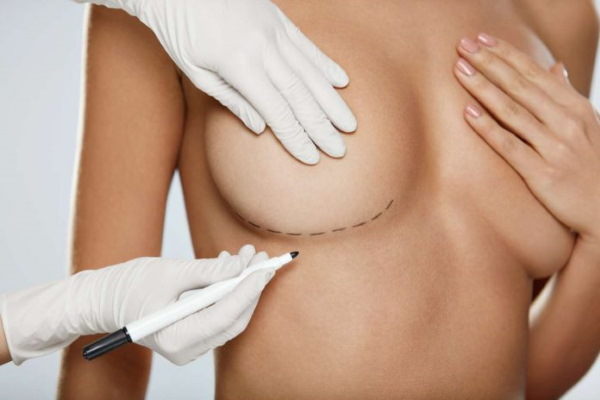
A half-month lift is indicated for women with moderate deformities of the mammary glands (1-2 degrees of tubulation). An incision is made in the crescent lobe, capturing the upper areolar semicircles.
After the operation, the breasts take on the correct shape and the nipple is moved to the right place. Periareolar mastopexy involves an incision along the contour of the age spot. The scars after such operations are almost invisible.
To eliminate significant deformities with tubulation or ptosis of grade 3, an extended incision is made from the areola to the inframammary fold. Endoprosthetics is also very popular.
Contraindications and consequences
Surgical interventions for the tubular form of the breast have a number of contraindications.

These include:
- period of childbearing and breastfeeding;
- benign and malignant neoplasms in the chest area;
- children or adolescents (up to 18 years old).
Mammoplasty can be considered a safe procedure. The operation must be carried out by a highly qualified specialist in compliance with all standards of asepsis and antiseptics.
The consequences that occur after arthroplasty include:
- Pathological edema. Most often, tissue swelling goes away on its own 3-5 days after surgery. If a woman is haunted by severe pain, temperature jumps, local low-grade fever, hyperemia are observed, then it is necessary to consult a doctor as soon as possible.
- To gray. In this case, the lymphatic fluid accumulates in the subcutaneous fat. The condition can be provoked by non-anatomical tissue dissection.
Signs include reddening of the scar, aching severe pain in the incision area, the release of clear fluid from the scar, and severe swelling. With serous syndrome, drainage or dissection of the wound is necessary, followed by pumping out of fluid.
- Subcutaneous hemorrhage. Against the background of unskilled actions of a plastic surgeon, improper stopping of bleeding or tissue injury during cutting. Small hematomas are considered the norm, they disappear on their own after 5-7 days.
Extensive hematomas that affect the armpit and shoulder area indicate the need to see a doctor. Most often, patients complain of severe pain and fever. The doctor must first stop the bleeding.
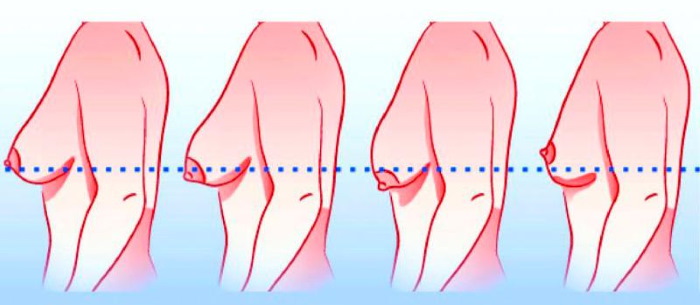
- Sagging breasts. A complication occurs when the size of the implant is incorrectly selected. It forms after 3-6 months. after operation.
Sagging can be pronounced and artificial (if a woman has a small prosthesis installed, then the breast drops or the body reacts in this way to a foreign body). The defect can be corrected only with the help of repeated mammoplasty.
- Implant contouring. Complications are detected in women with a thin subcutaneous fat layer. The contours in this case can be seen through the skin. Characteristic symptoms include an unnatural protrusion. Corrective fillers, which are introduced into the mammary gland, will help to correct the situation.
- Suppuration. This is the most dangerous complication, which is formed against the background of non-compliance with the rules of antisepsis and asepsis. Women complain of redness, temperature fluctuations, severe swelling and pain.
Pus may drain from the nipple or postoperative scar. It is easiest to stop inflammation at the initial stage with antibacterial drugs and antieptics. In advanced cases, repeated surgery is required.
- Capsular contracture. Connective tissue is formed around the implant. If growth does not occur correctly, then capsular contracture is formed. The chest is deformed, when palpating, dents and seals are revealed, the woman experiences severe pain.
Stage 1-2 contracture is eliminated with anti-inflammatory drugs, massage and physiotherapy. Stage 3-4 can only be corrected through surgery.
- Skin rash. Ripping is characterized by the formation of folds that vaguely resemble fingerprints. The defect is most noticeable when tilted. The condition is formed against the background of an incorrectly sized implant. To eliminate it, lipolifting is used.
To minimize the risk of complications after surgery, it is necessary to contact highly qualified specialists who have the appropriate certificates and diplomas in their hands.
Stages of the operation to correct the tubular breast
Surgical interventions on the female breast are considered one of the most complex plastic surgeries. The procedure should be carried out by a specialist with extensive experience in this area and an intuitive understanding of the problem. Each anomaly is individual, therefore an integrated approach is important.
The operation includes four stages:
- correction of the shape of the breast;
- mammoplasty (implantation of hydrogel or silicone implants);
- moving the areola-nipple complex to the desired point;
- the formation of the breast fold.
During surgery, the specialist must eliminate the periareolar hernia (if any) and correct the asymmetry of the mammary glands by reducing the interthoracic space.
Selection of the implant
Before the operation, the specialist must agree with the patient on all stages of the surgical intervention.
Endoprostheses should be chosen of the highest quality that meet the following criteria:
- Low risk of rupture. It is recommended to select the most durable implants that will not rupture in case of injury or falls.
- Safety. Almost all fillers present in prostheses are completely safe for women.
- Biocompatibility. The main component is a gel, which remains in place when cut. Implants are made of modern materials, so prostheses take root well in a woman's body.
With a tubular form of the mammary gland, hydrogel or silicone implants are implanted.
The former include:
- Highly cohesive gel. The dense material does not flow out if damaged, the risk of rupture is minimal.
- Cohesive standard gel. It resembles jelly in consistency. If the prosthesis ruptures, then the gel dissolves in the body on its own.
Bioimplants contain carboxymethyl cellulose, a natural polymer of natural origin. The substance is completely safe for the human body. When the prosthesis ruptures, carboxymethylcellulose breaks down into carbon dioxide, water and glucose.
After implantation, a woman can examine the breast by means of X-ray: the implant passes X-rays well. Today, dentures that are smooth in texture are rarely implanted.
For the tubular form of the mammary glands, implants with a textured surface are used. They do not overgrow with connective tissue, which minimizes the risk of complications after implantation.
Allocate teardrop (anatomical) and round. Prostheses belonging to the first category are suitable for women suffering from ptosis or grade 3 tubular mammary gland. In terms of structure, these prostheses are quite dense, so they retain their shape well.
When choosing a prosthesis, the doctor must take into account the individual characteristics of the patient's body structure:
- breast density;
- body proportions;
- the size of the sternum (hypersthenic, normostenic, asthenic);
- elasticity of the skin;
- natural breast size.
After receiving all the data, the doctor analyzes and selects the most suitable implants in terms of volume and shape.
Prosthetics
The implant is inserted into 2 quadrants: into the lower part of the breast (under the mammary gland) or the upper part of the breast (under the pectoral muscle). The specialist makes a tissue incision along the border of the areola and pushes the skin flaps apart. The bridges that interfere with the growth of the breast are cut off.
An implant is inserted into the space that has formed after these manipulations. After the endoprosthesis is installed, the blood that has entered the cavity is removed. The fabrics are slightly stretched and stitched together, cosmetic stitches are applied to the surface.
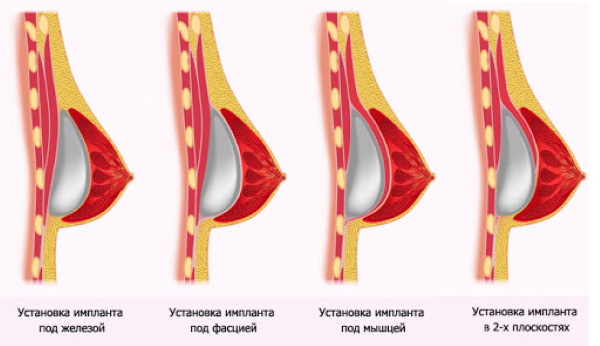
If a woman has a small breast or the skin does not stretch well, then after excision, an expander should be installed into the cavity, which helps to stretch the tissue. It must be regularly pumped with a solution. Stretching is carried out for 5-8 months. This is the safest and most painless method.
Breast lift (mastopexy)
Mastopexy is an operation to restore the shape of the breast.
The procedure has contraindications, which include:
- eczema at the incision site or pustular lesions of the epidermis;
- the period of gestation and breastfeeding;
- psychosomatic diseases;
- the presence of malignant and benign tumors inside the breast;
- diabetes;
- poor blood clotting;
- pathology of severe internal organs (including renal, hepatic and heart failure);
- cysts, mastopathy, cicatricial changes in the gland;
- acute infections.
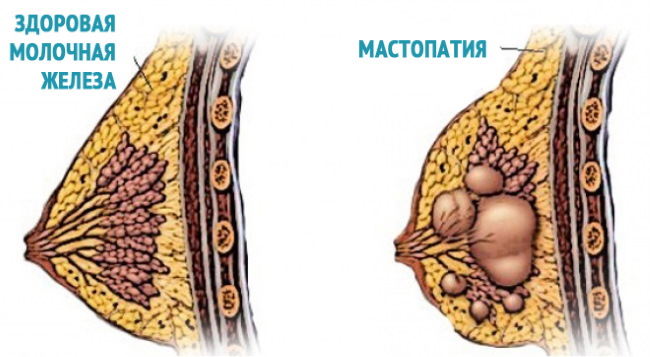
Before the operation, the patient must undergo a series of studies and consult with specialists (gynecologist, neurologist, cardiologist, therapist).
She can be assigned:
- electrocardiogram;
- mammography or ultrasound;
- tests for syphilis, hepatitis and HIV;
- general analysis of urine and blood.
14 days before the proposed operation, the doctor must completely cancel hormonal and blood-thinning medications. A woman should get rid of bad habits (smoking, drinking alcohol) in advance.
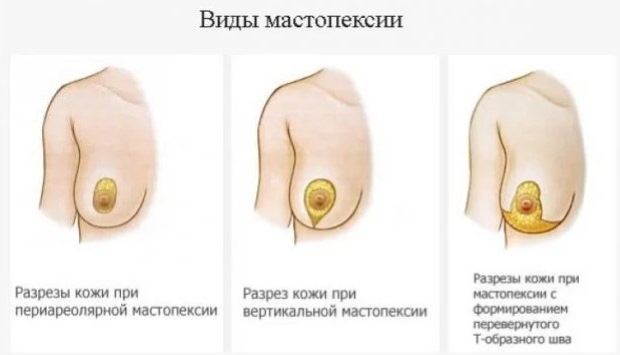
A breast lift is performed in several ways:
- mastopexy with implantation;
- periareolar mastopexy;
- vertical mastopexy.
The operation includes several stages:
- the skin is treated with an antiseptic;
- make a cut along the lines outlined in advance;
- excess skin is excised and the nipple is moved to the desired point;
- apply a cosmetic suture;
- treat the skin with antiseptics;
- cover the wounds with napkins.
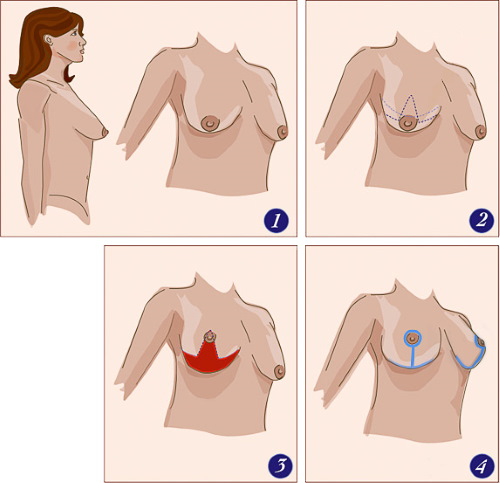
If there is blood left inside the cavity, it is necessary to install a drainage that will ensure the outflow of biological fluid. Types of mastopexy are distinguished by the size and location of the incision. During the operation, excess skin is excised, the edges of the wound are sewn together, and a cosmetic suture is applied.
Grade 3 breast tubulation can be corrected with an anchor or vertical lift. The incisions are located under the breast or near the nipple line. The operation is considered difficult - there are more scars compared to other surgical procedures.
Rehabilitation period after plastic surgery
If the operation is successful, the patient is discharged 24 hours after the surgery. During this time, specialists once again examine the woman and identify possible complications. After discharge, you must follow a number of recommendations to speed up the healing process.
You cannot spend a lot of time in a supine position, it is better to rest sitting or reclining. Food can be taken no later than 5 hours after surgery, and water - after 3 hours. Cold compresses will help to relieve pain.

You can take a shower on the 5th day after the operation. The seams are pre-sealed with a plaster. You cannot wash your head yourself: Restrict hand movements for 30 days.
The bath is taken 6 weeks after the operation. In the first 7-10 days after plastic surgery, the patient should take analgesics and anti-inflammatory medications. During this period, the risk of side effects is high. Diarrhea or constipation usually goes away on its own.
The stitches are removed 14-16 days after the plastic surgery. It is recommended to refrain from playing sports and intimate relationships for 10-14 days. They return to physical activity gradually, 30-35 days after plastic surgery. It is strictly forbidden to consume alcohol and tobacco products for 45-60 days after the operation.
Correction cost
The cost of the operation may vary depending on the type of tubulation and the severity of the defects.
Approximate prices:
| Intervention type | Price |
| Mammoplasty (endoprosthetics) | 120,000 - 240,000 rubles. (including the cost of prostheses) |
| Periareolar mastopexy | 165,000 - 245,000 (excluding the cost of the prosthesis) |
| Vertical mastopexy | 210,000 - 220,000 (without implants) |
| Anchor mastopexy | From 240,000 rubles. |
The total amount includes the cost of consultation, examination, anesthesia and the implants themselves. If a complex intervention is expected, then the patient will need to pay for the hospital stay.
Alternative Breast Correction Options
You can correct the shape of your breasts without resorting to surgery. Alternative methods will help women with mild tubularity.
If the defect is subtle, the specialist prescribes a number of physiotherapy procedures for the patient:
- Microcurrents. The procedure stimulates metabolism, accelerating the process of collagen production. Under the influence of microcurrents, the elasticity of the skin increases.
- Myostimulation. During the session, an electric current acts on the pectoral muscles. It increases the onus of the pectoralis minor and pectoralis major.
At home, you can do a number of exercises on your own to get your mammary glands back in shape.
Exercises to restore the elasticity of sagging breasts
A set of exercises that allows you to tighten the pectoral muscles and restore the shape of the mammary gland:
- Bench press.
You need to lie on a bench with your feet on the floor. Take dumbbells in your hands. Bend the right and left arms at the elbow, lift up. Fix the position. You need to do 4-5 sets of 10 repetitions per day.
- Push ups. Perform from a lying position on the floor or leaning against a wall. When push-ups, hands must be fully extended. The exercise is repeated 4 times, performing 10 sets.
- Palm press. Stand up, leaning against the wall, bend your arms at chest level, bringing your palms together. Inhale, hold your breath for 10 seconds and press your palms together with force. Repeat the exercise after 15 seconds. The number of approaches is 6-8.
You can only tighten your breasts if the above exercises are performed regularly.
Cosmetology procedures
Cosmetological procedures will help to correct the tubular shape of the breast. Meso-cocktails and preparations containing hyaluronic acid are injected into the mammary glands.
If a woman has small breasts, then you can restore the shape with the help of lifting threads:
- Aptos. The active ingredient is polylactic acid.It is not required to remove them, the threads are independently absorbed in the tissues. Participate in the formation of a framework of elastin and collagen.
- Mesothreads. The main component is polydioxanone, the coating is polyglycolic acid. Completely dissolve in 250-280 days.
- Platinum and gold threads. They are made of precious metals (999 standard, 24 carats). They do not dissolve on their own, after being overgrown with connective tissue, they contract.
During the implantation of threads, the patient is not immersed in sleep, she can observe the process. The procedure is completely safe and painless.
The tubular shape of the breast is corrected after puberty. Operations on the mammary glands in adolescence are not performed. The end result depends on the individual characteristics of the organism - in some cases, implants take a long time to take root.
Video about breast changes
The tubular form of the mammary glands:

